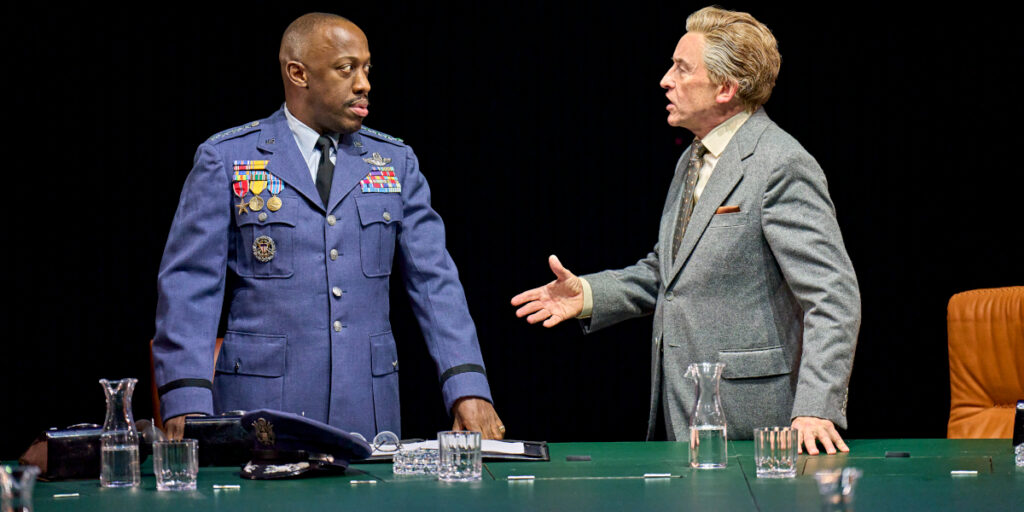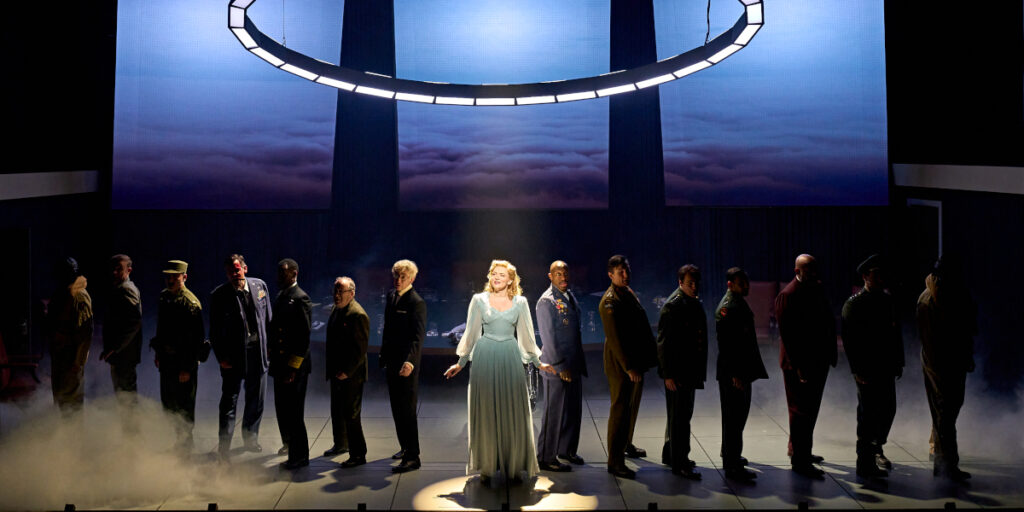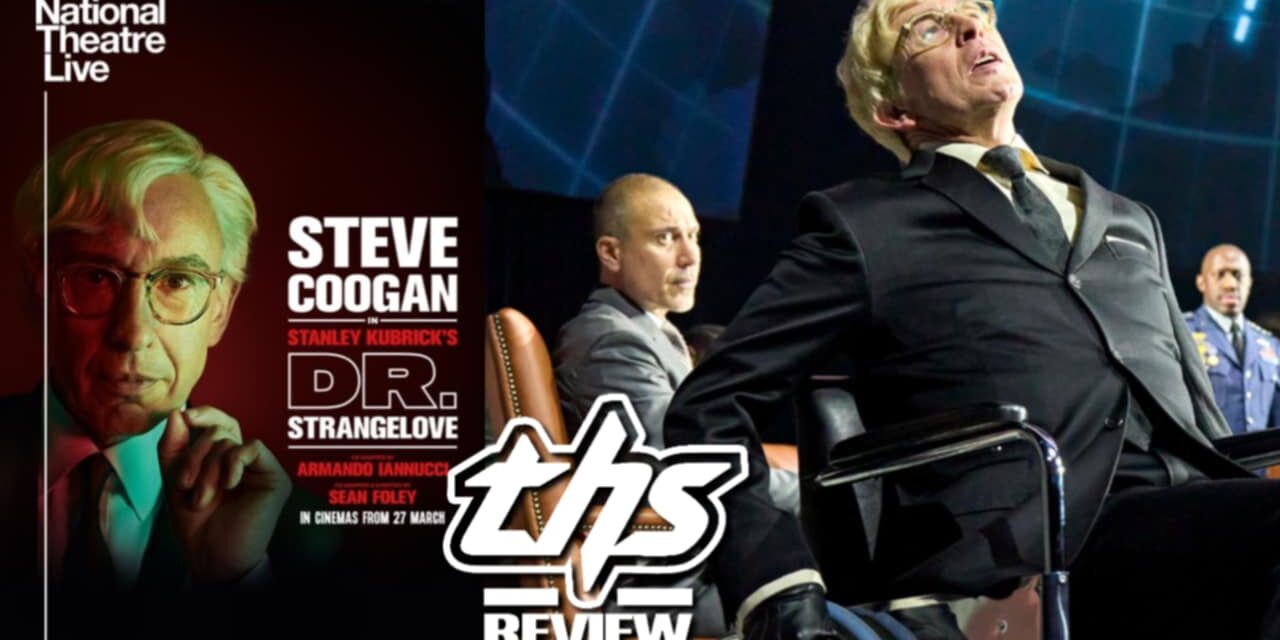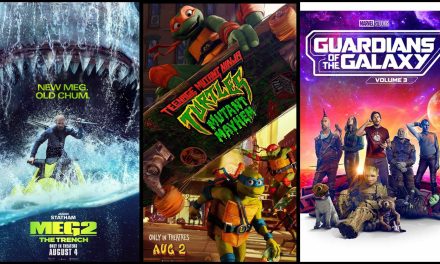Anyone who stands confidently and announces that they’re remaking a classic film could be considered a fool. If that same claim expanded to include a stage transfer of an absurdist Stanley Kubrick masterpiece, like National Theatre Live: Dr. Strangelove, this supposed fool could seem crazier. Yet somehow, when comedy geniuses Armando Iannucci and Steve Coogan (along with co-adapter/director Sean Foley) put such intentions into the world, with a result that packs an atomically comedic punch that’s both fresh and familiar.
Thanks to the theatrical release of the 2024 – 2025 West End production (which is now streaming through National Theatre at Home), I can confirm that my bold spirit of curiosity for the future actually paid off. The story hasn’t been altered to any terrible degree of “reimagining,” but instead has been adapted to a new medium. So the story of how General Jack D. Ripper (John Hopkins) dragged the world into a “shooting war” of thermonuclear proportions is just as bat guano you remember it.
What differs is both the venue, as well as the delivery of this time-tested tale. And that’s all for the better, as a new generation of Dr. Strangelove fanatics could find themselves joining the choir at a time when we need it most.
Dr. Strangelove’s Stage Reimagining Nails The Original’s Absurdity, While Modernizing Where Able
Movies don’t always translate well on the stage, with even the dialogue-heavy Strangelove posing a challenge in some places. In this particular instance, the hurdles to clear happened to be the story’s location hopping (part of which sends us to the cockpit of a B-52 bomber), and the multiple roles played by Steve Coogan. Co-adapter/director Sean Foley and his team address those issues rather perfectly, in ways that may surprise even the most savvy theater fan.
There were always going to be obvious differences between the cinematic experience of Dr. Strangelove and its staged equivalent. With that firmly staked in the ground, this adaptation does keep every narrative nut and bolt important to its survival intact. At the same time, while Stanley Kubrick, Terry Southern, and Peter George’s script still hits every note devotees would expect, the tune has changed a little bit for today’s troubled times.
You can tell where Armando Iannucci and company’s unique blend of humor start to creep in; this is after all, the man who created The Thick of It and Veep. That’s actually a compliment to the writing team who brought us National Theatre Live: Dr. Strangelove, as this fresh take on political absurdist humor meshes well with the original tale. It makes for a true adaptation, and not a mere mimic of its source material – something that’s highlighted even further in the casting of the piece.

Steve Coogan’s Multiple Performances Thread Together A Top Shelf Cast
Somewhere, Stanley Kubrick is smiling in the great beyond, as his dream of Peter Sellers playing four characters has finally been realized, thanks to Steve Coogan. As President Muffley, Dr. Strangelove, and Group Captain Mandrake, the Alan Partridge vet would have fit the bill rather nicely. But taking on the fourth role of Major Kong, Coogan goes all the way on the original dream; and you can totally see why that was intended.
One could see all four of those figures as directions on the same moral compass that’s being tested in Dr. Strangelove’s tale of nuclear paranoia. Steve Coogan is a natural fit in each of these roles, with his own chameleonic tendencies bringing darkly comic life to each station. At the same time, this artistic choice also helps highlight the fact that the rest of the cast on display are exemplary, and completely eschew mere imitations of their film counterparts.
Giles Terera’s General Buck Turgidson is another perfect example, as the part originally inhabited by George C. Scott sees a new lease on life through reinterpretation. There’s a playful energy that Terera infuses in his gruff militarism, which defies the expectations one would set compared to Scott’s more stoic portrayal.
One certainly wouldn’t catch the Patton star delivering the line, “I know, right?” as if he were exuding the energy of a ’90s teen being bummed out. That touch is just one of the many slight alterations that add up to new excitement in this familiar thread. Even through characters like Mark Hadfield’s Faceman, we see the impish mischief that Armando Iannucci engages in taking center stage, as the President’s right-hand man tries to keep cool in the face of toe-to-toe nuclear combat.

Fans Will Love How The Modern Strangelove Stands Shoulder To Shoulder With Its Counterpart
Dr. Strangelove (or How I Learned To Stop Worrying, And Love The Bomb) is a classic for a reason. It expressed the panic of atomic war through a lens so cathartically funny that it ages as well as the worries it’s tied to. Sean Foley’s adaptation respects the legacy of Stanley Kubrick’s picture, but takes a chance on switching things up. You’ll see no better example of that practice at work than in the new musical numbers that bookend the production, especially through Penny Ashmore’s beautifully chilling rendition of “We’ll Meet Again”.
After experiencing National Theatre Live: Dr. Strangelove, it actually feels like this tale always belonged on the stage. Who would have thought that escalating humor, a tight knit cast of characters, and monologuing opportunities would be the bridge between good films and fantastic theater? An entertaining example of adaptation at its finest, this production lends the current craze of stage transfers for movie classics some optimism.
If they can get Dr. Strangelove right, what’s to say that other gems (Kubrick or otherwise) can’t be revitalized through hands as steady as those of Sean Foley and Armando Iannucci? In a time fraught with worry about global power structures, humanity’s inhumanity to itself, and yes even atomic weapons, this project only proves that when a team puts this much effort into the game you can’t help but to stop worrying and love the “remake.”
For more Reviews, make sure to check back to That Hashtag Show.


![Spy x Family Ch. 89: Yuri The Yor Fu Master [Review]](http://18.211.146.234/wp-content/uploads/2023/11/Spy-x-Family-Ch-89-review-440x264.png)

![The Doctor Strange In The Multiverse of Madness Gallery Diorama Could Be One Of The Best From DST [Review]](http://18.211.146.234/wp-content/uploads/2023/01/doctor-strange-review-440x264.jpg)
